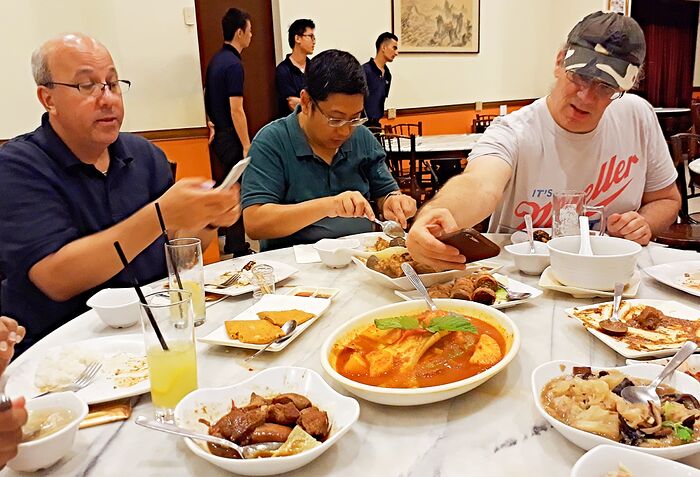Guan Hoe Soon (founded 1953) is one of the earliest Peranakan/Nyonya restaurants in Singapore. It’s strategically located on Joo Chiat Place in Katong district, right in the heart of the Baba-Nyonya community in Singapore.
The founder was not Peranakan/Straits-born Chinese, but Hainanese - not a surprise, since the Hainanese has dominated the housekeeping/service industry and the culinary world in Singapore since the early-20th-century, and were often employed as household chefs in colonial British and elite Peranakan households.
Hainanese emigre, Yap Chee Quee, started off as a housekeeper for a wealthy Peranakan family in Katong. He then opened Guan Hoe Soon Nyonya restaurant with his hard-earned savings, and named it after his three sons, Yap Kow Guan, Yap Kow Hoe and Yap Kow Soon. Today, the restaurant is managed by Yap Kow Soon’s efficient daughter, Jenny Yap, whose husband, Raymond Ou Yong, does all the cooking.
-
Sambal timun - a cucumber relish which is served at the beginning of a meal to whet the appetite. It consisted of fresh cucumber, chopped raw onions and chicken livers/gizzards in a spicy sambal belacan (chili-fermented shrimp paste) dressing.
-
Bakwan kepiting - one of my favourite soups: pork-crabmeat balls and bamboo shoots in a savoury pork-flavoured consomme. Done pretty well here although their rendition is not the best in Singapore. (The best ones are from Peranakan Inn on East Coast Road and Ivins in Binjai Park, Bukit Timah).
-
Beef rendang - slow-cooked dry beef curry, this is a Nyonya rendition of the Padang/Indonesian classic.
-
Babi Pongteh - slow-cooked pork in a fermented soybeans (taucheo) and coriander powder-scented stew.
-
Nyonya Chap chye - essentially, a Chinese mixed vegetable dish consisting of stewed cabbage, wood-ear fungus, shitake mushrooms, shrimps, pork, flavoured with a typical Nyonya blend of condiments which include fermented soybeans (taucheo), candlenuts and shallots.
-
Ayam Buah Keluak - This Nyonya classic chicken dish uses buah keluak, hard-shelled walnut-sized Indonesian nuts which actually contained cyanide. The raw buah keluak seeds are poisonous, but cured seeds (i.e. caked in tree ash and buried underground for a period) are perfectly safe to eat. One needs to soak the seeds in water for 3 days, then crack the nuts so the insides, which people here call Nyonya truffles can be eaten. The Ayam Buah Keluak is a deep-flavoured stew replete with the flavours of chilis, galangal, lemongrass, coriander, shallots and belacan (fermented shrimp paste). The sauce gets a sharp acidic stab from the addition of tamarind paste.
-
Ngoh hiang - this is a Hokkien (Fujianese) meat roll of pork forcemeat, scented with Chinese 5-spice, wrapped in tofu skin (yuba) and deep-fried. The Baba-Nyonya community descended from mainly Fujianese immigrants who came to SE-Asia as long as 4 centuries ago, inter-married with locals, and came up with a unique community whose Chinese-Malay cuisine is perhaps one of the earliest examples of fusion cooking. But ngoh hiang is one of the dishes which stuck closely with its Chinese-Fujianese origins.
-
Otak-otak - spicy fish mousse wrapped in banana leaves and steamed. The dominant flavours are the fresh turmeric used, besides a spice blend of fresh dried chilis, galangal and candlenuts. Coconut creme is also used to enrich the mousse, and eggs to bind the whole concoction together.
-
Pomfret Asam - a whole fresh white pomfret, cooked in a sourish-spicy soup. Asam pedas derives its dominant flavours from the Nyonya holy trinity of chilis, lemongrass and belacan. But torch ginger (Malay: bunga kantan) is also added for its unique scent. The sourish flavours come from tamarind, but other souring agents like tomatoes and pineapple are also added.
-
Kueh bengka - the rendition here is pretty unique, in that the sticky pieces of steamed cassava pudding were rolled in fresh, grated coconut, before serving.
-
Selection of Nyonya desserts - We ordered a selection of Nyonya desserts to share at the end (clockwise from top-left): Bubur cha cha (warm), bubur cha cha (cold, topped with shaved ice), sago Gula Melaka, cendol and pulot hitam. Nyonya desserts are usually sweetened with Gula Melaka or palm sugar, which imparted a deep, mellow, almost smoky flavour to the desserts, and enriched using coconut milk.
The shaved ice used as topping for the cold desserts here are pretty coarse - not fine and snowy as the type we normally have in Korean bingsu.
Guan Hoe Soon provides a full range of Nyonya dishes, although I felt the quality of produce and standard of cooking were not as good as I remembered them to be from 2 decades back.
Address
Guan Hoe Soon Restaurant
40 Joo Chiat Place, Singapore 427764
Tel: +65 6344 2761
Operating hours: 11am-3pm, 6pm-9.30pm daily














